Part A, Attachment E_HH Pulse_Public-Facing Information (1)
Part A, Attachment E_HH Pulse_Public-Facing Information (1).docx
High-Frequency Surveys Program/Household Pulse Survey
Part A, Attachment E_HH Pulse_Public-Facing Information (1)
OMB: 0607-1029
Attachment E: Household Pulse Survey Public-Facing Information on census.gov
Household Pulse Survey Background for Survey Respondents and Other Public-Facing Information
HOUSEHOLD PULSE SURVEY BACKGROUND FOR SURVEY RESPONDENTS https://www.census.gov/programs-surveys/household-pulse-survey.html
Household Pulse Survey: Measuring Social and Economic Impacts during the Coronavirus Pandemic
Data collection for Phase 3.10 of the Household Pulse Survey started on August 23, 2023 and is scheduled to continue until October 30, 2023. This latest version of the survey will continue with a two-weeks on, two-weeks off collection and dissemination approach, with data releases scheduled for September 20, October 11, and November 8, 2023.
Overview
The Household Pulse Survey is a 20-minute online survey studying how the coronavirus pandemic and other emergent issues impacting households across the country from a social and economic perspective.
The HPS also asks about core demographic household characteristics (including sexual orientation and gender identity), as well as the following topics:
Access to infant formula
Children’s mental health treatment
COVID-19 vaccinations and long COVID symptoms and impact
Use of antivirals to treat COVID-19
Education, specifically K-12 enrollment
Childcare arrangements
Employment
Food sufficiency
Housing security
Household spending, including energy expenditures and consumption
Inflation concerns and changes in behavior due to increasing prices
Physical and mental health
Feelings of pressure to move from rental home
Transportation, including behavioral changes related to the cost of gas
Health insurance coverage (including Medicaid)
Shortage of critical products
Impact of living through natural disasters
In order to support the nation’s recovery and the social and economic well-being of U.S. households, we need to know the ways the pandemic and other issues have affected people’s lives and livelihoods. Data from this survey will show the widespread effects of the coronavirus pandemic and other critical matters on individuals, families, and communities across the country.
Your participation will help federal and state officials direct aid, assistance, and support to the people and places that need it most. This survey provides information that cannot be collected elsewhere. Your response is key.
Prior data collections phases
Phase 1: April 23, 2020 - July 21, 2020
Phase 2: August 19, 2020 - October 26, 2020
Phase 3: October 28, 2020 - March 29, 2021
Phase 3.1: April 14, 2021 - July 5, 2021
Phase 3.2: July 21, 2021 – October 11, 2021
Phase 3.3: December 1, 2021 – February 7, 2022
Phase 3.4: March 2, 2022 – May 9, 2022
Phase 3.5: June 1, 2022 – August 8, 2022
Phase 3.6: September 14, 2022 – November 14, 2022
Phase 3.7: December 9, 2022 – February 13, 2023
Phase 3.8: March 1, 2023 – May 8, 2023
Phase 3.9: June 7, 2023 – August 7, 2023
How was I selected to be in this survey?
The Census Bureau randomly chose your address, not you personally, to participate in this survey. A limited number of addresses from across the country were scientifically selected to represent the entire population.
Your participation is important, and your response cannot be replaced by one from another household address.
How do I complete the survey?
If you have been selected to participate in the Household Pulse Survey, you will receive an email from survey@census.gov or a text message from 39242* (message and data rates may apply) with a link to complete the survey. If we have not received a response from you, you may receive up to 3 follow-up reminders.
Only those whose addresses have been selected to participate can complete the survey. A limited number of addresses across the country have been invited to answer the Household Pulse Survey.
Email communications from the Census Bureau regarding the Household Pulse Survey will originate from a census.gov email address. Text messages will be sent from 39242. The link to the survey will include "survey.census.gov" in the URL.
*Respondents may Reply “Stop” to opt out of receiving text messages.
Household Pulse Survey Questionnaire (In Field Beginning August 23, 2023) [< 1.0 MB]
Encuesta del Pulso de los Hogares (In Field Beginning August 23, 2023) [< 1.0 MB]
How do I know my information is safe? Can I be identified by my responses?
The U.S. Census Bureau is required by law to protect your information. The Census Bureau is not permitted to publicly release your responses in a way that could identify you. We are conducting this voluntary survey under the authority of Title 13, United States Code, Sections 8(b), 182 and 193 to study the economic impacts of the coronavirus pandemic and other social and economic issues in the United States. Federal law protects your privacy and keeps your answers confidential (Title 13, United States Code, Section 9). Per the Federal Cybersecurity Enhancement Act of 2015, your data are protected from cybersecurity risks through screening of the systems that transmit your data.
Your privacy is protected by the Privacy Act (Title 5, U.S. Code, Section 552a). Routine uses of these data are limited to those identified in the Privacy Act System of Record Notice titled, “SORN COMMERCE/Census-3, Demographic Survey Collection (Census Bureau Sampling Frame).” The Census Bureau can use your responses only to produce statistics and is not permitted to publicly release your responses in a way that could identify you.
Is this survey authorized by law?
This collection has been approved by the Office of Management and Budget (OMB). This eight-digit OMB approval number, 0607-1013, confirms this approval and expires on 10/31/2023. We are required to display this number to conduct this survey.
We estimate that completing this survey will take 20 minutes on average. Send comments regarding this estimate or any other aspect of this survey, including suggestions for reducing the time it takes to complete this survey to adrm.pra@census.gov.
Who is conducting this survey? How will my responses be used?
The Census Bureau is the designated federal statistical agency conducting this survey.
The HPS continues to be a collaborative undertaking and is fielded in partnership with the following federal agencies:
National Center for Immunization and Respiratory Diseases (NCIRD)
National Institute for Occupational Safety and Health (NIOSH)
All information that you provide is used only to create accurate, relevant statistics about the nation’s people, places, and economy. These statistics help inform officials and policymakers about communities and individuals across the United States impacted by the pandemic.
HOUSEHOLD PULSE SURVEY – VERIFYING SURVEY LEGITIMACY
https://www.census.gov/programs-surveys/surveyhelp/verify-a-survey.html
How to verify an email or text message is from the Census Bureau
Some surveys such as the Household Pulse Survey may contact you via text message. The Household Pulse Survey uses the number 39242 (message and data rates may apply*) to send a link to complete the survey online.
Emails from the Census Bureau are sent from the official @census.gov domain.
Any links included in a Census Bureau email will direct you to an official federal government website ending in .gov.
Emails from the Census Bureau will have instructions or information to complete a survey online, by phone with a Census Bureau representative, or by paper. The Census Bureau will not ask you to provide your personal information via email.
The Census Bureau will never ask for your full Social Security number, bank account number, or passwords.
*Respondents may Reply “Stop” to opt out of receiving text messages.
CENSUS BUREAU EXPERIMENTAL DATA SERIES
https://www.census.gov/data/experimental-data-products.html
What are Experimental Data Products?
MAY 14, 2021
Experimental data products are innovative statistical products created using new data sources or methodologies that benefit data users in the absence of other relevant products. We are seeking feedback from data users and stakeholders on the quality and usefulness of these new products.
The development of experimental data is one important path towards the creation of new, regularly occurring statistical products. Experimental data products that meet our quality standards and demonstrate sufficient user demand may enter regular production if resources permit.
Census Bureau experimental data may not meet all of our quality standards. Because of this, we clearly identify experimental data products and include methodology and supporting research with their release.
EXPERIMENTAL DATA SERIES: HOUSEHOLD PULSE SURVEY
https://www.census.gov/householdpulsedata
Measuring Household Experiences during the Coronavirus Pandemic
August 23, 2023
Data collection for Phase 3.10 of the Household Pulse Survey started on August 23, 2023, and is scheduled to continue until October 30, 2023. This latest version of the survey will continue with a two-weeks on, two-weeks off collection and dissemination approach.
What is the Household Pulse Survey?
The U.S. Census Bureau, in collaboration with multiple federal agencies, is in a unique position to produce data on the social and economic effects of coronavirus on American households. The Household Pulse Survey was designed to deploy quickly and efficiently, collecting data to measure household experiences during the coronavirus pandemic. It has evolved to include content on other emergent social and economic issues facing households. Data will be disseminated in near real-time to inform federal and state action.
Note: The COVID-19 Vaccination Tracker, which focused on the number of Americans receiving at least one-dose of a COVID-vaccine, has been discontinued following phase 3.2 of the HPS. Data users can continue to access an archived version from the HPS Research and Presentations webpage.
If you have been invited to participate in the survey, find more information here.
Household Pulse Survey Questionnaire (In Field Beginning August 23, 2023) [< 1.0 MB]
Encuesta del Pulso de los Hogares (In Field Beginning August 23, 2023) [< 1.0 MB]
What information does the Household Pulse Survey collect?
The Household Pulse Survey measures how the coronavirus pandemic and other emergent issues are impacting households across the country from a social and economic perspective.
The HPS also asks about core demographic household characteristics (including sexual orientation and gender identity), as well as the following topics:
Access to infant formula
Children’s mental health treatment
COVID-19 vaccinations and long COVID symptoms and impact
Use of antivirals to treat COVID-19
Education, specifically K-12 enrollment
Childcare Arrangements
Employment
Food sufficiency
Housing security
Household spending, including energy expenditures and consumption
Inflation concerns and changes in behavior due to increasing prices
Physical and mental health
Feelings of pressure to move from rental home
Transportation, including behavioral changes related to the cost of gas
Health insurance coverage (including Medicaid)
Shortage of critical products
Impact of living through natural disasters
The HPS continues to be a collaborative undertaking and is fielded in partnership with the following federal agencies:
National Center for Immunization and Respiratory Diseases (NCIRD)
National Institute for Occupational Safety and Health (NIOSH)
The data collected will enable the Census Bureau to produce statistics at the national and state levels and for the 15 largest Metropolitan Statistical Areas (metro areas).
When will Data be Made Available from the Household Pulse Survey?
Data releases for Phase 3.10 of the survey are scheduled for September 20, October 11, and November 8, 2023.
What are the previous collection cycles of the survey?
Phase 1: April 23, 2020 - July 21, 2020
Phase 2: August 19, 2020 - October 26, 2020
Phase 3: October 28, 2020 - March 29, 2021
Phase 3.1: April 14, 2021 - July 5, 2021
Phase 3.2: July 21, 2021 – October 11, 2021
Phase 3.3: December 1, 2021 – February 7, 2022
Phase 3.4: March 2, 2022 – May 9, 2022
Phase 3.5: June 1, 2022 – August 8, 2022
Phase 3.6: September 14, 2022 – November 14, 2022
Phase 3.7: December 9, 2022 – February 13, 2023
Phase 3.8: March 1, 2023 – May 8, 2023
Phase 3.9: June 7, 2023 – August 7, 2023
How is the Household Pulse Survey Different from Other Surveys Conducted by the Census Bureau?
The Census Bureau and its federal statistical partners are considered the preeminent source of the nation's most important benchmark surveys. Many of these surveys have been ongoing for more than 80 years and provide valuable insight on social and economic trends.
The production of these benchmark surveys is by nature a highly deliberative process. While COVID-19 questions were introduced into some of these surveys, many surveys have ceased to collect such data and the process to release the data from these surveys can take months, sometimes years, before data are made publicly available.
The approach for the Household Pulse Survey is different: it is designed to be a short-turnaround instrument that provides valuable data to aid in the pandemic recovery. The Census Bureau is fielding the Household Pulse Survey as a part of the agency’s Experimental Data Series; as such, data products may not meet some of the Census Bureau’s statistical quality standards. Data are subject to suppression based on overall response and disclosure avoidance thresholds.
EXAMPLES OF HOUSEHOLD PULSE SURVEY DATA TOOL AND TABLES
Data Tool: https://www.census.gov/data-tools/demo/hhp/#/
Data Tables: https://www.census.gov/programs-surveys/household-pulse-survey/data.html
Public Use File: https://www.census.gov/programs-surveys/household-pulse-survey/datasets.html
Data Tool Snapshots (examples):
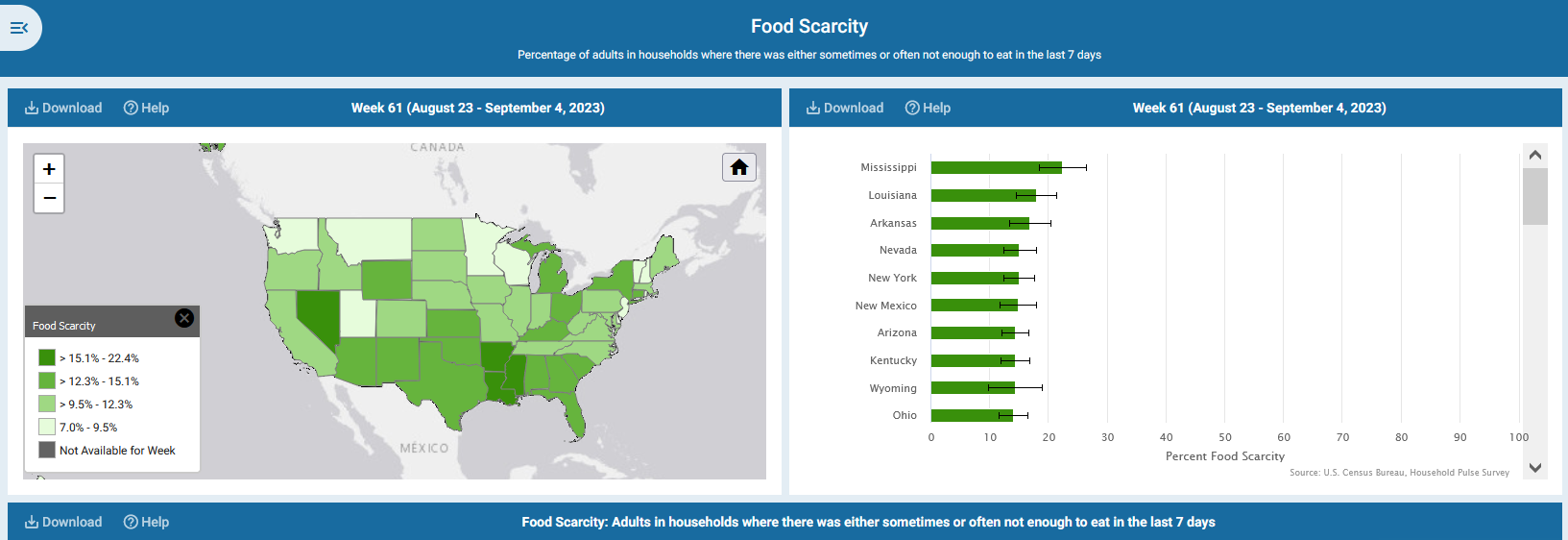

Data Tables (with selected examples):
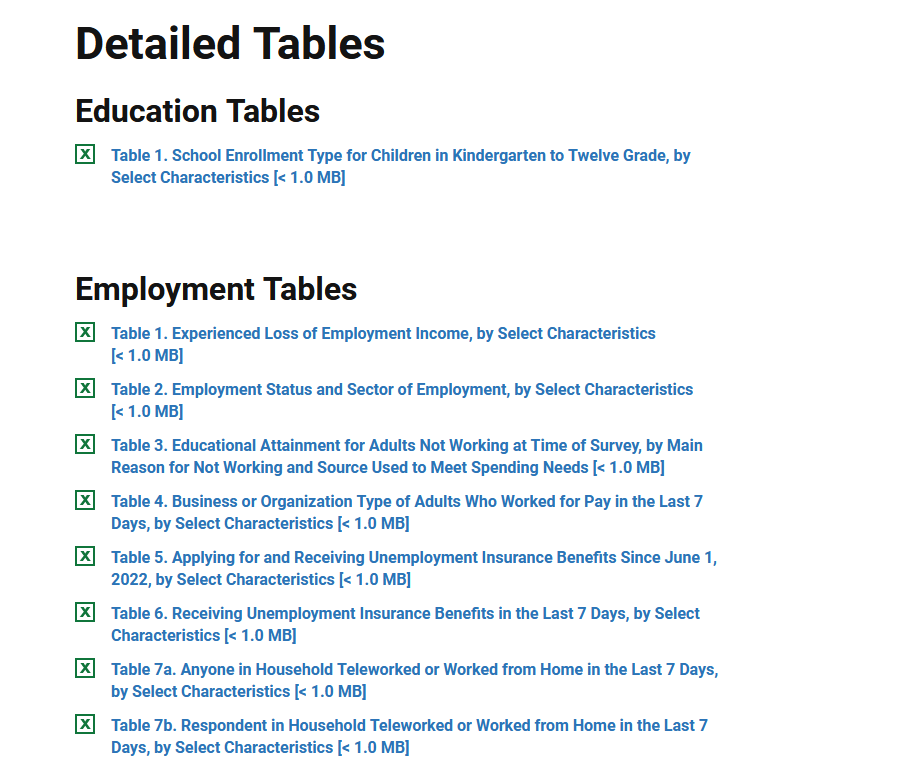
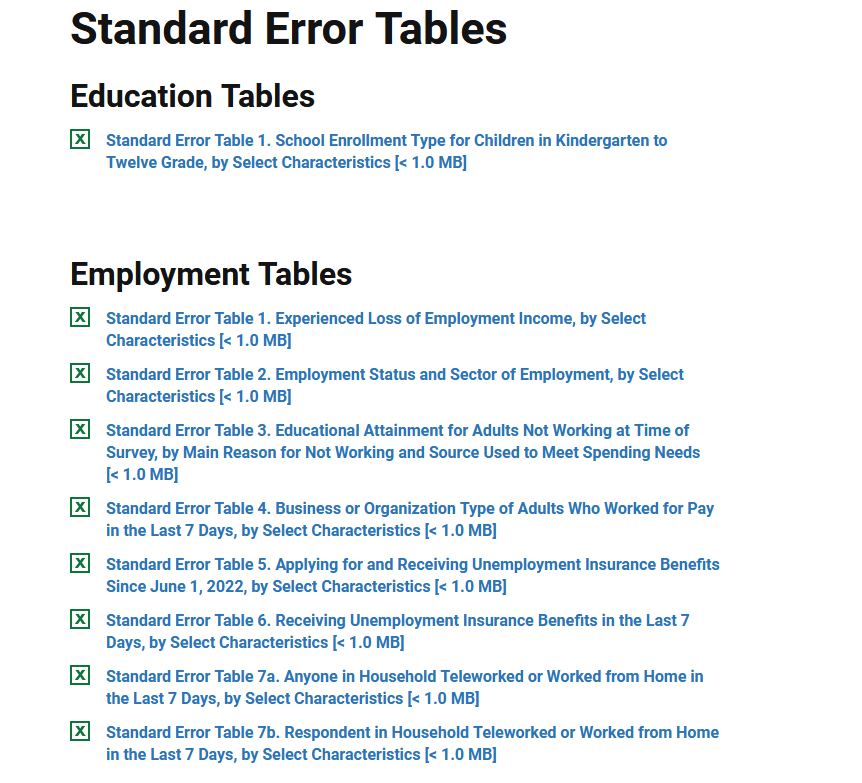
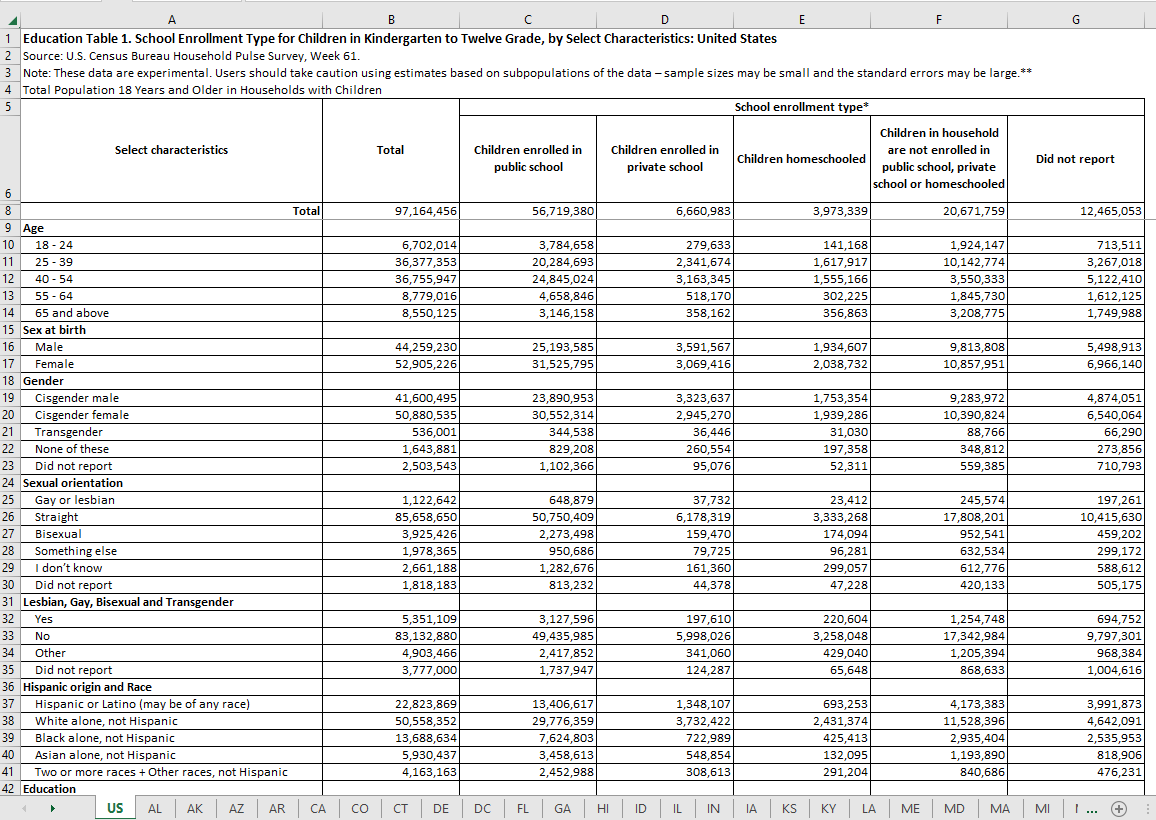

Public Use Files
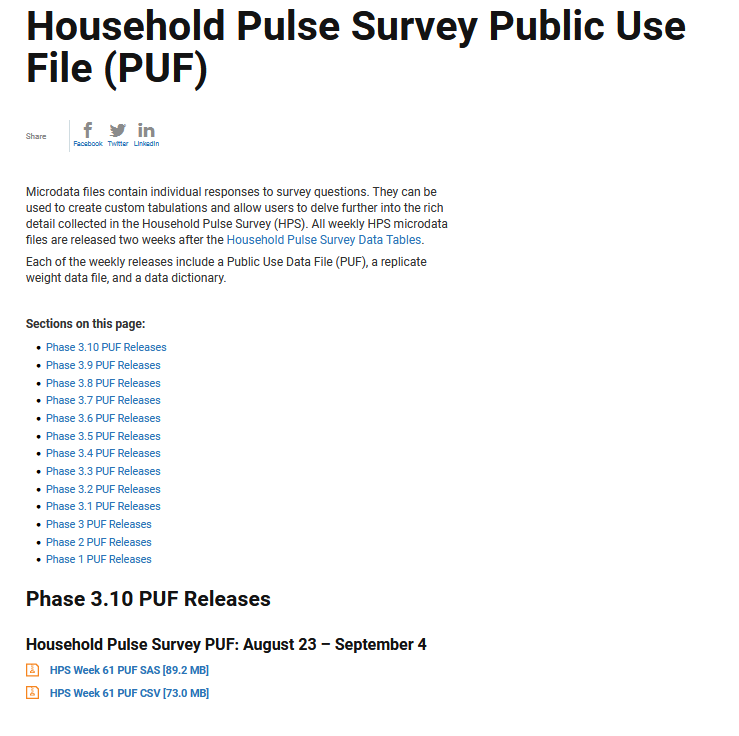
| File Type | application/vnd.openxmlformats-officedocument.wordprocessingml.document |
| Author | Cassandra Logan (CENSUS/ADDP FED) |
| File Modified | 0000-00-00 |
| File Created | 2023-11-01 |
© 2026 OMB.report | Privacy Policy